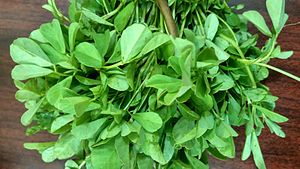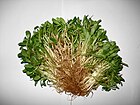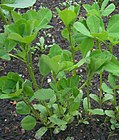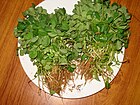Note: This is a project under development. The articles on this wiki are just being initiated and broadly incomplete. You can Help creating new pages.
Trigonella foenum-graecum - Medhika
Trigonella foenum-graecum is an annual plant in the family Fabaceae, with leaves consisting of three small obovate to oblong leaflets. It is cultivated worldwide as a semiarid crop, and its seeds are a common ingredient in dishes from the Indian subcontinent. It's leaves and seeds of medhika plant are widely used in Indian cuisine.
Uses
Diabetes, Constipation, Greasy stools, Loss of appetite, Gastric problem, Peptic Ulcers, Intestinal Gas, Flatulence, Abdominal Distension, Colon Cancer.
Parts Used
Chemical Composition
Foenum-graecum leaf is used as a green, leafy vegetable and is a good source of calcium, iron, β-carotene and several vitamins[1]
Common names
| Language | Common name |
|---|---|
| Kannada | Mente, mentepalle |
| Hindi | Methi |
| Malayalam | Uluva |
| Tamil | Vendayam |
| Telugu | |
| Marathi | NA |
| Gujarathi | NA |
| Punjabi | NA |
| Kashmiri | NA |
| Sanskrit | Bahuparni, Gandhaphala |
| English | Fenugreek, Greek-clover, Greek hay |
Properties
Reference: Dravya - Substance, Rasa - Taste, Guna - Qualities, Veerya - Potency, Vipaka - Post-digesion effect, Karma - Pharmacological activity, Prabhava - Therepeutics.
Dravya
Rasa
Tikta (Bitter), Kashaya (Astringent)
Guna
Laghu (Light), Ruksha (Dry), Tikshna (Sharp)
Veerya
Ushna (Hot)
Vipaka
Katu (Pungent)
Karma
Kapha, Vata
Prabhava
Habit
Identification
Leaf
| Kind | Shape | Feature |
|---|---|---|
| Simple | alternate | The leaves are alternate, compound, trifoliolate, 7-12 cm long, light green in colour |
Flower
| Type | Size | Color and composition | Stamen | More information |
|---|---|---|---|---|
| Unisexual | 2-4cm long | Blue | 5-20 | The flowers are papillonaceous, borne in leaf axils, white, lemon-yellow or purplish blue in colour |
Fruit
| Type | Size | Mass | Appearance | Seeds | More information |
|---|---|---|---|---|---|
| Oblong | 2-10 cm | The fruits occur as straight or sickle-like pods of 2-10 cm | green-olive or brownish in colour | 10-20 seeds | {{{6}}} |
Other features
List of Ayurvedic medicine in which the herb is used
Where to get the saplings
Mode of Propagation
How to plant/cultivate
Succeeds in ordinary garden soil, preferring a well-drained loamy soil in full sun. Requires a warm, sheltered position in Britain[4]
Commonly seen growing in areas
Photo Gallery
References
- ↑ "Chemical compounds"
- ↑ "plant description"
- ↑ Cite error: Invalid
<ref>tag; no text was provided for refs namedAyurvedic preparations - ↑ "Cultivation details"
External Links
- Pages with reference errors
- Ayurvedic Herbs known to be helpful to treat Diabetes
- Ayurvedic Herbs known to be helpful to treat Constipation
- Ayurvedic Herbs known to be helpful to treat Greasy stools
- Ayurvedic Herbs known to be helpful to treat Loss of appetite
- Ayurvedic Herbs known to be helpful to treat Gastric problem
- Ayurvedic Herbs known to be helpful to treat Peptic Ulcers
- Ayurvedic Herbs known to be helpful to treat Intestinal Gas
- Ayurvedic Herbs known to be helpful to treat Flatulence
- Ayurvedic Herbs known to be helpful to treat Abdominal Distension
- Ayurvedic Herbs known to be helpful to treat Colon Cancer
- Herbs with Leaves used in medicine
- Herbs with Seeds used in medicine
- Herbs with common name in Kannada
- Herbs with common name in Hindi
- Herbs with common name in Malayalam
- Herbs with common name in Tamil
- Herbs with common name in Sanskrit
- Herbs with common name in English
- Habit - Annual plant
- Index of Plants which can be propagated by Seeds
- Index of Plants which can be propagated by Cuttings
- Herbs that are commonly seen in the region of Field verges
- Herbs that are commonly seen in the region of Uncultivated ground
- Herbs that are commonly seen in the region of Dry grasslands
- Herbs
- Fabaceae








